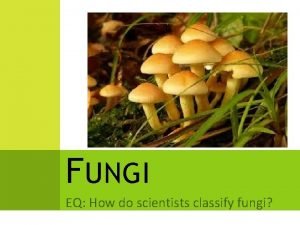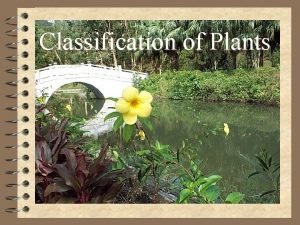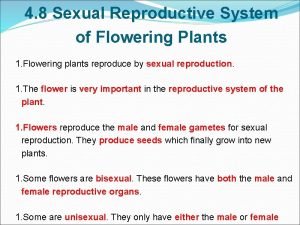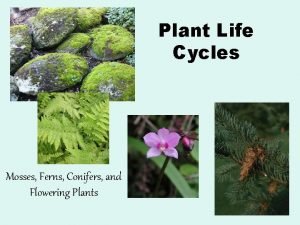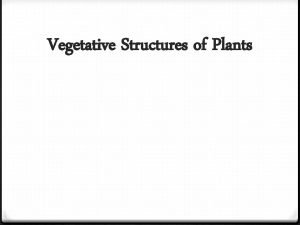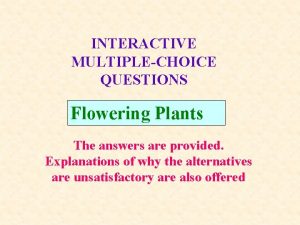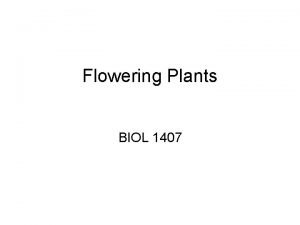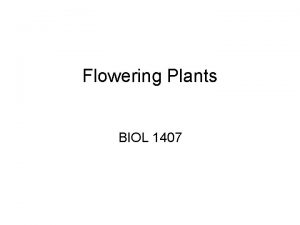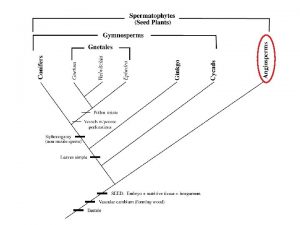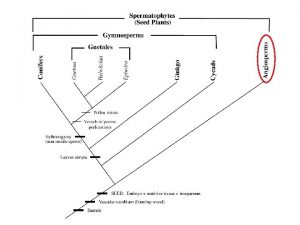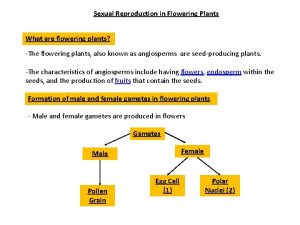4 8 Sexual Reproductive System of Flowering Plants








- Slides: 8

4. 8 Sexual Reproductive System of Flowering Plants 1. Flowering plants reproduce by sexual reproduction. 1. The flower is very important in the reproductive system of the plant. 1. Flowers reproduce the male and female gametes for sexual reproduction. They produce seeds which finally grow into new plants. 1. Some flowers are bisexual. These flowers have both the male and female reproductive organs. 1. Some are unisexual. They only have either the male or female

Structure and Function of the Flower 1. The parts of a flower are the sepals, petals, stamen and pistil. They are arranged in four rings and are attached to the receptacle at the end of the flower stalk

Structure and Function of the Flower Structure Characteristic Function Sepal Outermost whorl, usually green Protects the flower during bud stage Petal Second whorl, usually coloured Attracts insects and animals Stamen Consists of filament and anther Male reproductive part Pistil Made up of the stigma, style and Female reproductive part ovary

Structure and Function of the Flower 1. Sepals form the outermost ring of the flower. They are usually green in colour and may look like leaves. They protect the flower during the bud stage. 1. Petals form the second ring of the flower. 1. They are the most obvious parts of the flower. They are usually brightly coloured and often scented. (b) At the bud stage, the petals protect the stamens and pistil of the flower. (c) When the flower is in full bloom, the brightly coloured petals attract insects for pollination.

Structure and Function of the Flower 1. Stamens are the male reproduction organs of the flower. Each stamen is made up of two parts: 1. The filament is a long stem-like structure. It is attached to the receptacle at one end and holds an anther at the other. 1. The anther is made up of two to four lobes. Inside the anther are pollen sacs where the pollen grains are formed. 5. The anther and pollen grains may have

Structure and Function of the Flower 6. 1. Each pollen grain has two nuclei inside the cytoplasm. 1. The cytoplasm is surrounded by two layers of walls. 1. The surface of the pollen grain is rough, to enable it to stick to the stigma. 1. The bigger nucleus is called the generative nucleus which forms the male gametes. 1. The smaller one is called the tube nucleus.

Structure and Function of the Flower 1. The pistil is the female reproduction organ of the flower. It is also known as the carpel. Each pistil is made up of the following parts. 1. The stigma, which has a sticky surface for the pollen grains to attach (e. g hibiscus). Some flowers have featherlike stigmas to catch the pollen grains (e. g grass and maize flowers). 1. The style joins the stigma to the ovary. It is made up of soft tissues which allows the pollen tube to grow down towards the ovule. 1. The ovary is attached to the receptacle of the flower. It surrounds and protects the ovule inside. 1. The ovules are attached to the ovary wall. Inside the ovule is the ovum, the female gamete.

Structure and Function of the Flower Question 1. Give two differences between the sepals and the petals of a hibiscus flower. Petal Sepal Big Small Red Green 1. Jane planted two papaya trees in her garden. After a few months both plants started to flower. However, only one plant bears fruits. Why? -Papaya plants have unisexual flowers that are either male or female flowers. The papaya plant with no fruits possibly has only male flowers. Thus fertilisation does not take place and no fruits are formed.

